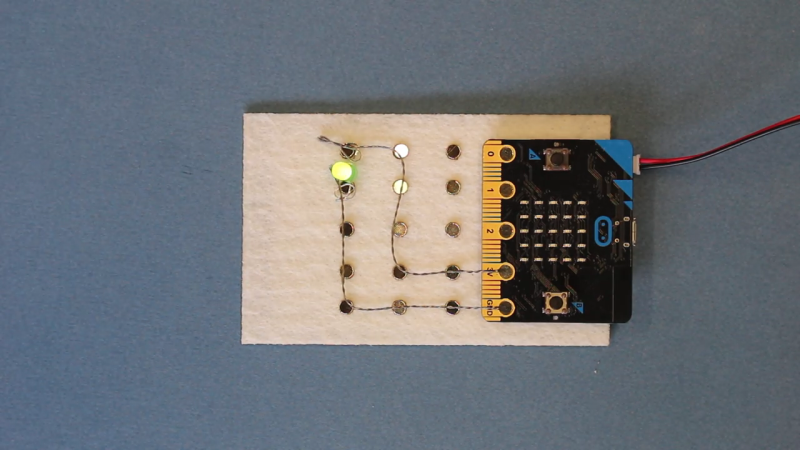How do you prototype e-textiles? Any way you can that doesn’t drive you insane or waste precious conductive thread. We can’t imagine an easier way to breadboard wearables than this appropriately-named ThreadBoard.
If you’ve never played around with e-textiles, they can be quite fiddly to prototype. Of course, copper wires are floppy too, but at least they will take a shape if you bend them. Conductive thread just wants lay there, limp and unfurled, mocking your frazzled state with its frizzed ends. The magic of ThreadBoard is in the field of magnetic tie points that snap the threads into place wherever you drape them.
The board itself is made of stiff felt, and the holes can be laser-cut or punched to fit your disc magnets. These attractive tie-points are held in place with duct tape on the back side of the felt, though classic double-stick tape would work, too. We would love to see somebody make a much bigger board with power and ground rails, or even make a wearable ThreadBoard on a shirt.
Even though [chrishillcs] is demonstrating with a micro:bit, any big-holed board should work, and he plans to expand in the future. For now, bury the needle and power past the break to watch [chris] build a circuit and light an LED faster than you can say neodymium.
The fiddly fun of e-textiles doesn’t end with prototyping — implementing the final product is arguably much harder. If you need absolutely parallel lines without a lot of hassle, put a cording foot on your sewing machine.
















Using a breadboard is that difficult?
It’s pretty hard to jam conductive thread in it, yeah.
But if you’re prototyping on a bench, just use regular wires? Once the circuit checks out, repeat the exact same circuit but with conductive thread in clothes? I don’t know, I must be missing something.
Today I learned: conductive thread is magnetic.
Cool, magnets are great for wearables! You can even solder to nickel-plated rare earth magnets if you’re careful and quick, but the heat will damage them if you aren’t.
Some Cornell researchers found that you can mitigate the heat damage by surrounding your magnet with ferromagnetic stuff like iron or steel while you solder it, though. And that does seem to help in my limited anecdotal experience:
https://web.archive.org/web/20150118013255/http://myip.cctec.cornell.edu/index.cfm/ts.details?tk=K4AB2317153854938841&from=search
Magnets sure are weird, huh?
I seem to be totally missing this. First off, is the thread magnetic or is it that it takes on magnetic properties when current runs though it like any other conductor? I can not see that being a very strong magnetic force with only a few miliamps going through it. It would be interesting to take a small strong magnet and hold it near one of the battery cables in a car when the engine gets turned over to see if you could feel it though.
Second, I thought the idea behind conductive thread was to you know, sew it into things. I am not seeing what the magnets do to assist in that end.
I could see magnets being used as low density “snappable” connectors, but if I were going to go down that road I would solder the conductive thread to a piece of copper tape, use a nail or something to make an upward facing dimple in the tape and epoxy the magnet onto the tape, leaving the dimple to give a good electrical contact between the tape and the magnet. The tape could than be stuck and sewn on the fabric. Two of these could snap together and make a good connection.
First, from the video you can see the thread is magnetic before it’s even connected, so yes the thread is magnetic.
Second, if you sew conductive thread and components into an article of clothing before prototyping the circuit, you’re going to have a bad time.
If you try to solder thread, you’re going to have a worse time, and your plan would require the magnets themselves to be sewn into the clothing, which would be very inconvenient and negate the purpose of using conductive thread in the first place.
I am in a place that has metered internet so for now, videos are a no go. But you are kidding about sewing the thread in before prototyping right? Pretty much every anything I have ever saw that used conductive thread was just led’s. Do you really need to prototype wire run’s to led’s? Even switches.
BTW, if you can not solder the thread, how do you terminate it? Crimp it?
If you look at the fatigue properties of copper, they’re terrible. I can imagine that it’s not handy to use copper in textile because it’s folded and wrinkled that many times. Probably because of that reason they’re using steel wires. More resistance, but if the currents are small enough that shouldn’t be a big problem. It will last much longer.
That depends on the copper, both the alloy and how it is laid out. You see no steel in the thin wires going to headphones or in the old days telephone handsets, and they were just about indestructible.